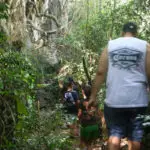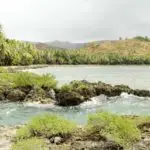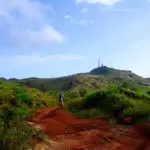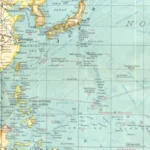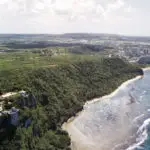Geography of Guam
Table of Contents
Share This
Largest of the Marianas
At 13 degrees north latitude and 144 degrees east longitude, the island of Guam is the largest in size (214 square miles), the most populated, and the southernmost of the 15 Mariana Islands in the western Pacific Ocean. In addition, the Marianas archipelago is a significant physiographic boundary with the Pacific Ocean Basin found on the eastern edge of the Philippine tectonic plate.
Along this geologic boundary, subduction occurs, and it is common for earthquake activity. Fortunately, as the heavy Pacific floor moves slowly downward and under the Mariana Islands and below the Philippine plate, this movement – or subduction – is at great depths, therefore, lessening the effects of the earthquake activity at the surface of Guam and the other Mariana Islands. The deepest valley in the Pacific Ocean floor – marked by the subduction – is just southwest of Guam named the Marianas Trench, more than 6.8 miles below the ocean surface.
Guam is also the largest of the more than 2,000 islands in the vast region of Micronesia. The region of Micronesia (Greek: mikros =small, and nesos =island), or tiny islands, consists of the modern political states: the Federated States of Micronesia containing all of the islands of Yap, Chuuk, Pohnpei, and Kosrae; the Republic of Belau (or Palau); the Republic of the Marshall Islands; the Commonwealth of the Northern Mariana Islands; and, parts of the Republic of Kiribati (formerly the Gilbert islands), Nauru, and Ocean Island (or Banaba).
Strategic position
Guam’s position is about the same distance -1,500 miles- from both Manila, Philippines and Tokyo, Japan and about 3,800 miles west of Honolulu, Hawai’i. This important strategic position with the east-Asian realm gives Guam a reason for military importance.
Guam was seized by Captain Henry Glass of the US Navy during the Spanish-American War, in 1898, when the United States of America took the Philippines (along with Cuba, Puerto Rico and other Caribbean islands) from Spain. Nearly 400 years before, Ferdinand Magellan had stumbled upon the Mariana Islands and before long Spain colonized Guam. The Spanish control of Guam remained for more than 350 years until the Americans took control and made the island of Guam a base with Apra Harbor the main commercial and military port for shipping activities. It was taken over by Japan during World War II for two and a half years and then re-taken by the Unites States in 1944. It remains a US territory.
Population
Today, Guam’s population is approximately 159, 358 (2010 US Census). The indigenous CHamoru people, while greatly changed from the first contacts by Spain and Spanish rule until now, remain the largest identifiable social-cultural group in Guam. The population, according to the US Census of 2000, places their percentage of the total population at 42. The Filipino people make up a significant 27 percent, and the mainland Americans amount to about 11 percent (depending on the US Military numbers) followed by minorities of Micronesians, Chinese, Koreans, and Japanese.
The districts and villages of the central and northern areas of Guam contain the largest numbers of people. The villages of Dededo, Tamuning and Yigo are the largest villages. The biggest three villages, along with Barrigada, Mangilao, Chalan Pago, Mongmong-Toto-Maite are all located in central-north areas of Guam, where population densities reach an average as high as 800 to 900 people per square mile.
Settlement in the whole southern half of Guam is basically coastal and considered rural. A main perimeter road extends from Apra Harbor, which is in west Guam, and connects the villages and districts of Hågat, Humåtak, Malesso’ which extend to the southwest, and then the villages and districts of Inalåhan, Talo’fo’fo, and Yona all found on or near the southeast coasts. The “cross-island road” or Route 17, provides the only highway across the northern part of Guam’s southland connecting Apra Harbor, Apra Heights, Sånta Rita-Sumai in the west to Talo’fo’fo and Yona in the east.
Climate
Guam, being a tropical island, has a relatively humid and warm climate throughout the year. While high atmospheric humidity and high air temperatures in the 80-degree Fahrenheit range prevails, the island can be quite comfortable during the months of December through April when the trade winds are strongest and the humidity is lower. The driest month on the average is March (two-to-three inches), and the wettest month is usually September (nine-to-ten inches).
Typhoon weather conditions perennially threaten the tranquility of Guam and many other islands in Micronesia. These cyclonic storms and other similarly formed storms bring high winds and heavy seas that can cause severe physical damage to settlements. Typhoon Pongsona, for example, directly hit Guam in early December 2002. Electrical power, water-pumping stations, and telephone and TV cable facilities were off for several weeks and full restoration to all homes occurred well after the New Year.
The great environmental attraction of Guam has to do with the combination of seascapes with coastal fringing reefs, and a varied topography. The tropical warm ocean with a myriad of blue-aqua-green water is magnificently viewed from the limited coastal plains or the many heights above the coasts. Guam is not particularly high, with Mt. Lamlam being the highest point at 1,332 feet. The various topographic regions make it seem large and many people live and work away from the coasts.
More than 1,500,000 tourists, mainly Japanese, come to Guam annually through the island’s international airport to stay in hotels and resorts largely around Tumon Bay. While the private economic sector is expanding, federal and local governments are the largest employers in this unique organized unincorporated US territory.
For further reading
Karolle, Bruce G. “Agriculture, Population, and Development in Guam Island: Some Options for the Future.” PhD diss., Michigan State University, 1978.
–––. The Atlas of Micronesia. 2nd ed. Honolulu: Bess Press, 1993.
Karolle, Bruce G., and Dirk A. Ballendorf. Prospects for Economic Self-Sufficiency in the New Micronesian States. Centre for Southeast Asian Studies, Occasional Paper 25. Townsville: James Cook University, 1986.
Guam Water Kids (Famagu’on Hånom Guahan). “Welcome to Guam Water Kids.” Last modified 12 January 2019.
Water and Environmental Research Institute of the Western Pacific and Island Research and Educational Initiative. “Digital Atlas of Southern Guam.” 1 January 2008.

